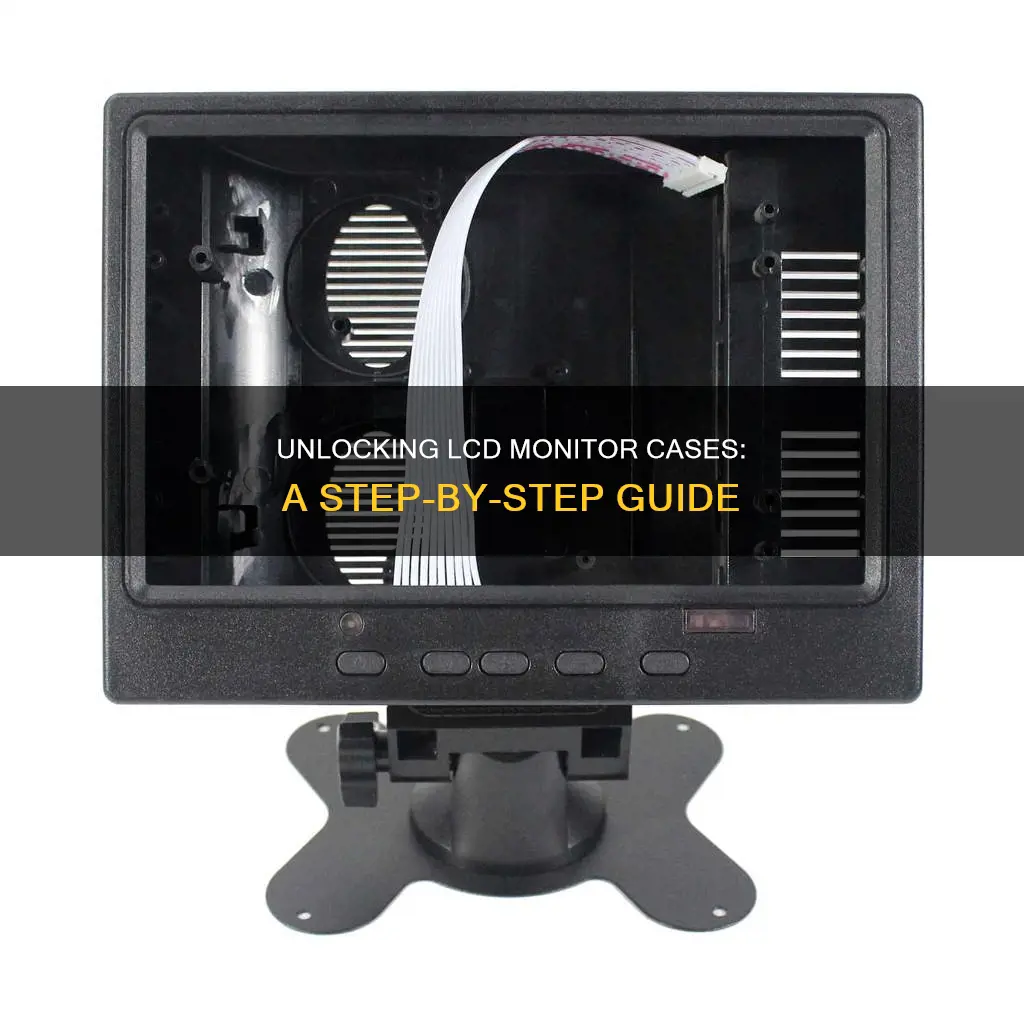
If you're looking to open an LCD monitor case, it's important to proceed with caution. LCD monitors contain capacitors that can store thousands of volts of electricity, even when they're turned off. Before you begin, ensure you know what you're doing and discharge any stored voltage to ground. Now, let's get started with the process:
1. Place the LCD monitor display side down.
2. Remove any visible screws on the back of the monitor and near the stand.
3. Gently insert a flat-head screwdriver between the front and back halves of the monitor.
4. Slide the screwdriver through the gap, feeling for plastic clips that hold the halves together.
5. Depress these clips until all of them are disengaged and the back of the monitor can be separated from the front.
6. Unplug cables from sockets on circuit boards and the inner back panel.
7. Remove any remaining screws from the side of the inner back panel and carefully lift it off the front display screen.
Remember to always ground your metal equipment to eliminate static electricity if you plan on using the monitor again after dismantling it.
What You'll Learn

Removing the stand
Generic Monitor Stand Removal
Before starting, ensure you have a screwdriver and a soft cloth to place the monitor on, so as not to scratch the screen.
- Turn off the computer and disconnect the power plug.
- Place the monitor on a soft cloth, screen-side down.
- Unscrew the bolts at the back of the monitor's case.
- Remove the screen cover.
- Untangle the cables from the stand.
- Remove the stand.
Detaching the Vertical Stand
- Check for any connections in the vertical part of the triple monitor desk mount base. There may be a connection between this section and the vertical stand holder.
- Check for screws holding the vertical stand in place. If there are none, look for buttons near or on the stand. Some monitors, such as Dell and Acer, require you to press a button to remove the stand.
- If there are no screws or buttons, gently pull the vertical stand away from the monitor, holding it by the sides, not the screen.
Removing Vertical Holders
- To remove the holder that connects the vertical stand, you may need to detach the back panel. As this component is mounted inside the monitor, it may be necessary to disassemble the monitor.
- Take the monitor to a local electronic repair shop if you are unsure about disassembling it yourself.
Specific Models
The process for removing the stand can vary depending on the brand and model of the monitor. Here are some specific instructions for popular monitor brands:
- LG: First, turn off the monitor and unplug all cords. Remove the screws from the back of the monitor. Slide the monitor out and turn it over on a soft cloth. Unscrew the bolt at the bottom of the monitor, then unscrew the screws on the back. Slide the monitor out and remove the stand.
- Samsung: Turn off the monitor and unplug it. Use a flathead screwdriver to remove the screws holding the stand to the monitor.
- Dell: Unplug the monitor from the power source. Loosen the plastic screws on the back of the monitor stand and remove them. You can then remove the stand. If it gets stuck, use a butter knife to pry it out, being careful not to scratch the stand.
- HP: Remove the screws holding the stand to the monitor. Carefully slide the stand off the monitor and remove the screws underneath.
- Acer: Turn off the computer and unplug the power cord and A/V cable. Remove the screws on the back of the screen and lift off the back panel. Gently lift the monitor panel and remove the stand.
Setting Up Eyefinity: Mixing Monitor Sizes
You may want to see also

Using a flat-head screwdriver to prise apart the monitor
To open an LCD monitor, you will need to use a flat-head screwdriver. This is a relatively straightforward task, but it is important to exercise caution as there are hazards involved.
First, place your LCD monitor display-side down on a flat surface. Remove any screws you see on the back of the monitor, including those near the stand.
Now, insert the head of the flat-head screwdriver into the gap between the front and back halves of the monitor. Carefully slide the screwdriver through the gap, feeling for any plastic clips holding the two halves together. When you feel resistance, twist and gently prise the casing apart. You should hear a clicking or snapping sound as the clips come apart.
Work your way around the monitor, repeating this process until all the clips have been disengaged and the back of the monitor comes away from the front. Be careful not to break the clips as you go.
Once the monitor is open, you will need to unplug the cables from the sockets on the circuit boards and inner back panel. Remove any remaining screws from the side of the inner back panel and pull it off the front display screen.
It is important to note that LCD monitors contain capacitors that can store thousands of volts of electricity, even after being turned off for days. Therefore, you should always ensure that you discharge the stored voltage before performing any repairs or maintenance.
Setting Up an Internal Camera for Your ASUS Monitor
You may want to see also

Dismantling the monitor's internal components
Before proceeding with any disassembly, ensure the monitor is unplugged and that you have discharged yourself of any static electricity by wearing an electrostatic wristband or grounding yourself.
- Place the monitor screen-side down on a soft cloth on a stable surface.
- Disconnect the stand from the monitor. Depending on the model, the stand may be screwed into the base or snapped in with plastic tabs. Use the appropriate tool for your model.
- Remove all the case screws fastening the back panel to the front panel. These are typically located around the perimeter and in the middle of the back panel.
- Gently lift and remove the back panel to access the internal components.
- Using a flat-head screwdriver, carefully pry up the tabs on the shield lamp.
- Disconnect the cables on the left and right sides of the monitor by gently pulling them out of their sockets.
- Lift and remove the shield lamp assembly.
- Disconnect the LVDS cable, which should now allow you to lift the LCD panel away from the frame.
- With the LCD panel removed, you can now access and service the internal components.
It is important to note that different monitor models may have slight variations in their assembly, so it is recommended to refer to specific model guides or seek professional advice if you are unsure about any steps. Additionally, always exercise caution when working with electronic devices, as certain components, such as the PSU, can retain a charge and pose a safety risk.
Setting Up a Home Wi-Fi Data Usage Monitor
You may want to see also

Locating and unscrewing the internal screws
Step 1: Removing the Stand and External Screws
Start by removing the stand of the LCD monitor. This will give you access to the rear of the monitor where most of the external screws are located. Unscrew all the visible screws around the edges and corners of the monitor. In some cases, there may be a hidden screw underneath the monitor stand, so make sure to check there as well.
Step 2: Separating the Front and Rear Cases
Insert a flat tool, such as a plastic paint scraper or a guitar plectrum, between the front and rear cases of the monitor. Gently rock the two halves apart, feeling for the direction in which they will separate. You will usually start in the middle of one side or the bottom, avoiding the corners. You should hear the clips popping as they release. Work your way around the periphery of the monitor, being careful not to break the clips.
Step 3: Locating Internal Screws
Once the front and rear cases are separated, you will have access to the internal components of the monitor. Carefully inspect the circuit boards, controller, and power supply for any screws holding them in place. These screws may be of different sizes and types, so make sure to take note of their locations and keep them organized.
Step 4: Unscrewing Internal Components
Using the appropriate screwdriver, carefully unscrew each of the internal screws that you located in the previous step. Some components may have multiple screws, so make sure to remove them all before attempting to remove the component. Be gentle and patient during this process to avoid stripping the screws or damaging the internal circuitry.
Step 5: Disconnecting Cables
After unscrewing the internal components, you will need to disconnect any cables or ribbons attached to them. Gently pry or pull the connectors apart, being careful not to damage the delicate pins or ribbons. Some cables may have locking latches, so be sure to release them before attempting to remove the cables.
By following these steps, you should be able to successfully locate and unscrew the internal screws of your LCD monitor case, allowing you to access and repair the internal components as needed. Remember to keep track of your screws and be gentle with the plastic clips and cables to avoid any damage during the disassembly process.
Ornate Monitor Growth: Full Size, How Fast?
You may want to see also

Discharging the capacitor
It is imperative to discharge a capacitor before handling it to avoid the risk of electrical shock. Capacitors store electrical energy and can retain dangerous voltage levels even after power is removed. Here are detailed instructions on how to discharge a capacitor safely:
Step 1: Disconnect the Capacitor
Turn off and unplug the device containing the capacitor. If it's a car, locate the battery and disconnect the cables from the negative and positive terminals. For household appliances, unplug the device from the wall outlet.
Step 2: Check the Voltage
Set a multimeter to its highest DC voltage setting and connect the probes to the capacitor's posts. If the reading is higher than 10 volts, proceed to discharge the capacitor.
Step 3: Prepare an Insulated Screwdriver
Use an insulated screwdriver with a rubber or plastic handle to avoid electric shock. Inspect the handle for any damage, such as tears or cracks, and ensure it is rated for the voltage you're working with.
Step 4: Grip the Capacitor
Hold the capacitor securely at its base with one hand, keeping your fingers away from the top where the posts are located.
Step 5: Discharge with the Screwdriver
Lay the screwdriver across both terminals of the capacitor simultaneously. You will see and hear the electric discharge in the form of a spark. Repeat this step to ensure the capacitor is fully discharged.
Alternatively, you can create a capacitor discharge tool by purchasing a 12-gauge wire, a 20k OHM 5-watt resistor, and two alligator clips. Connect the wires to the resistor and the alligator clips, then solder and insulate the connections. Clip one alligator clip to each terminal of the capacitor to discharge it.
Always remember to wear protective gear, such as insulated gloves, and ensure your tools are in good condition.
Monitor Size: How Big Is My Screen?
You may want to see also
Frequently asked questions
First, remove the monitor stand. Then, starting at the bottom edge, use a thin, flat-blade screwdriver to pry the case open and work your way around.
You will need a flat-head screwdriver and, optionally, a plastic tool like a paint scraper or a guitar plectrum.
Place the plug end of a lamp cord on the metal rods sticking out from the capacitor to discharge the stored voltage safely.
LCD monitors contain capacitors that can store thousands of volts of electricity, even when turned off. This can deliver a fatal electric shock.
Insert a flat-head screwdriver into the gap between the front and back of the monitor. Carefully slide it through, depressing any plastic clips holding the halves together until the back comes away from the front.







